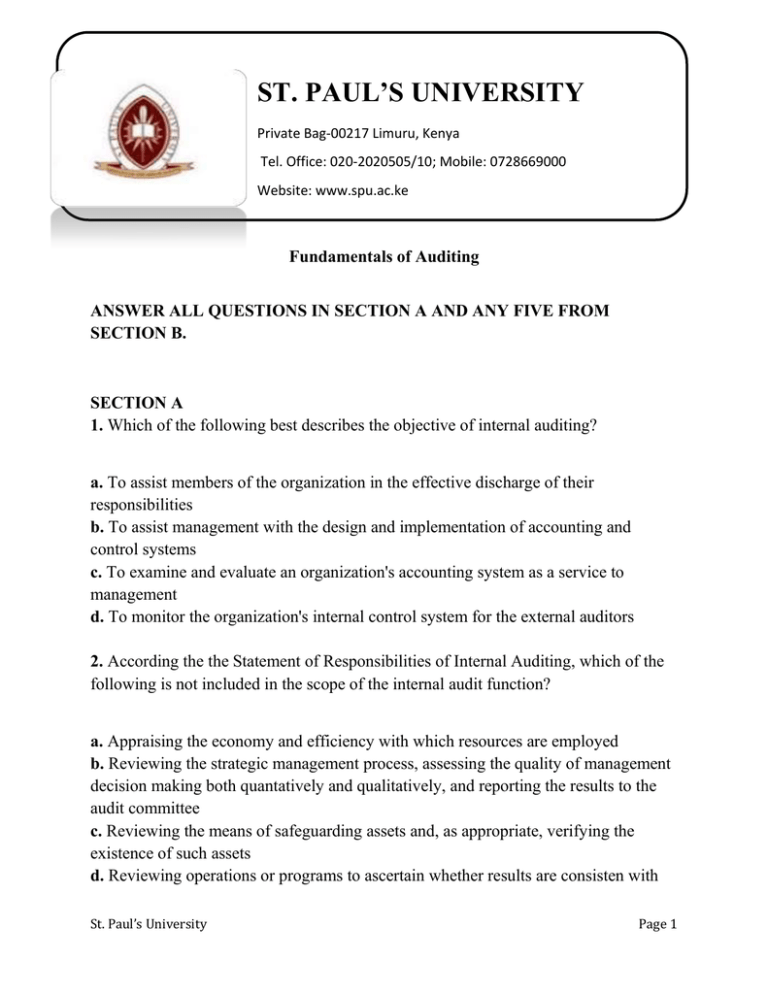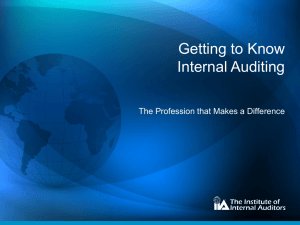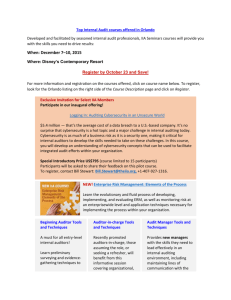Fundamentals of Auditing
advertisement

ST. PAUL’S UNIVERSITY Private Bag-00217 Limuru, Kenya Tel. Office: 020-2020505/10; Mobile: 0728669000 Website: www.spu.ac.ke Fundamentals of Auditing ANSWER ALL QUESTIONS IN SECTION A AND ANY FIVE FROM SECTION B. SECTION A 1. Which of the following best describes the objective of internal auditing? a. To assist members of the organization in the effective discharge of their responsibilities b. To assist management with the design and implementation of accounting and control systems c. To examine and evaluate an organization's accounting system as a service to management d. To monitor the organization's internal control system for the external auditors 2. According the the Statement of Responsibilities of Internal Auditing, which of the following is not included in the scope of the internal audit function? a. Appraising the economy and efficiency with which resources are employed b. Reviewing the strategic management process, assessing the quality of management decision making both quantatively and qualitatively, and reporting the results to the audit committee c. Reviewing the means of safeguarding assets and, as appropriate, verifying the existence of such assets d. Reviewing operations or programs to ascertain whether results are consisten with St. Paul’s University Page 1 established objectives and goals and whether the operations or programs are being carried out as planned. 3. Of the following, which is the major objective of The Institue of Internal Auditors? a. Cultivate, promote and disseminate information concerning internal auditing and related subjects b. Oversee the activities of internal auditors c. Promulgate standards that must be followed by all corporations d. Investigate accusations that Certified Internal Auditors have violated The Institute of Internal Auditors Code of Ethics 4. One of the purposes of the Standards for the Professional Practice of Internal Auditing as stated in the Introduction to the Standards is to a. Encourage the professionalization of internal auditing b. Establish the independence of the internal audit department and emphasize the objectivity of internal auditing c. Encourage external auditors to make more extensive use of the work of internal auditors d. Establish the basis for guidance and measurement of internal auditing performance 5. Which of the following statements does not describe one of the purposes of The IIA Code of Ethics? The IIA Code of Ethics a. Sets forth basic principles in the practice of internal auditing b. Charges IIA members to maintain high standards of conduct c. Explains the internal audit profession's responsibility to society at large d. States that a distinguishing mark of a profession is acceptance by its members of responsibility to those it serves 6. Independence permits internal auditors to render impartial and unbiased judgments. The best way to achieve independence is through St. Paul’s University Page 2 a. Individual knowledge and skills b. Organizational status and objectivity c. Supervision within the organization d. Organizational knowledge and skills 7. Which of the following is considered a major reason for establishing an internal audit function? a. To relieve overburdened management of the responsibility for establishing an effective control structure b. To safeguard resources entrusted to the organization c. To ensure the accuracy, reliability and timeliness of financial and operating data used in managment's decision making d. To assist members of the organization in the measurement and evaluation of the effectivenss of the established internal control structure 8. The internal auditor's responsibility for the prevention of fraud includes all of the following except a. Determining if the organizational environment fosters control consciousness b. Ensuring that fraud will not occur c. Being aware of activities in which fraud is likely to occur d. Evaluating the effectiveness of actions taken by management to deter fraud 9. The internal auditing profession is believed to have advanced primarily as a consequence of a. Increased interest by graduating students and experienced auditors b. The limitation of external audit scope c. Job qualification specifications that include added emphasis on background knowledge and skills d. Increased complexity and sophistication of business operations St. Paul’s University Page 3 10. The audit committee can serve several important purposes, some of which directly benefit internal auditing. The most significant benefit provided by the audit committee to the internal auditor is a. Protecting the independence of the internal auditor from undue management influence b. Reviewing annual audit plans and monitoring audit results c. Approving audit plans, scheduling, staffing and meeting with the internal auditor as needed d. Reviewing copies of the procedures manuals for selected company operations and meeting with company officials to discuss them 11. Which of the following best describes and internal auditor's purpose in reviewing the adequacy of the system of internal control? a. To help determine the nature, timing and extent of tests necessary to achieve audit objectives b. To ensure that material weaknesses in the internal control system are corrected c. To determine whether the internal control system provides reasonable assurance that the organization's objectives and goals are met efficiently and economically d. To determine whether the internal control system ensures that the accounting records are correct and that financial statements are fairly stated SECTION B 1. Explain the operating elements of an Information System. 2. List the sources of planning data. Explain. 3. Discuss the need of Information Technology. 4. What are the categories of MIS? Explain. 5. Explain the ethical issues of IT. 6. Explain the structure of LAN. 7. Explain the three basic categories of electronic commerce applications. St. Paul’s University Page 4 8. Discuss about ERP Implementations Cycle. 9. Define linear programming. State the procedure for formulating linear programming problems. 10. What are the steps followed in simplex method. Explain different approaches to probability. 11. Write the dual of given LPP Maximise z 3 X1 10 X 2 2X 3 Subject to 2X1 3 X 2 2X 3 7 3 X1 2X 2 4 X 3 3 X1 , X 2 , X 3 0 12. Solve the transportation problem by using North West Corner Rule. To Q1 Q2 Q3 Supply F1 50 30 200 1 From F2 90 45 170 3 F3 250 200 50 4 Demand 4 2 2 13. The joint probability mass function of random variables X and Y is given by 2x y P x, y , x 0,1, 2 and Y 2, 1, 0 . Find out the marginal probability mass 27 function of x and y , the conditional distribution of X / Y 1 and P X 2UY 0 . 14. A decision problem has been expressed in the following pay off table. Find the maximax and maximum pay off action. Strategy 1 2 3 A 1880 1840 1800 States B 1620 1600 1640 C 1400 1420 1720 St. Paul’s University Page 5








